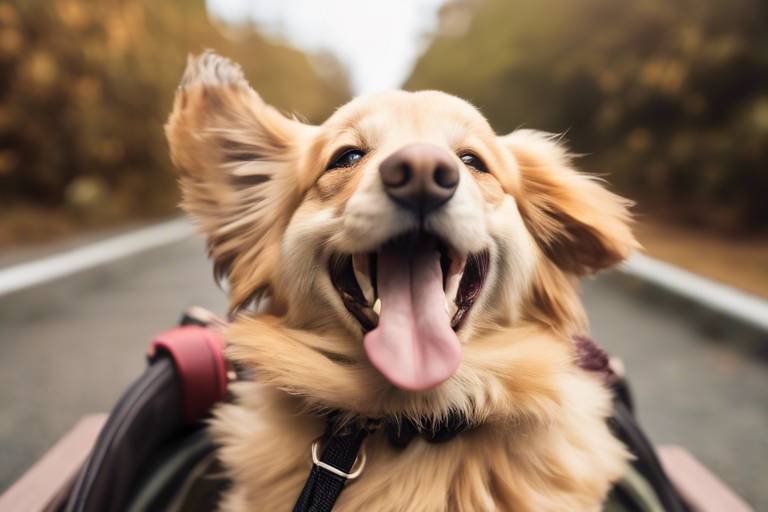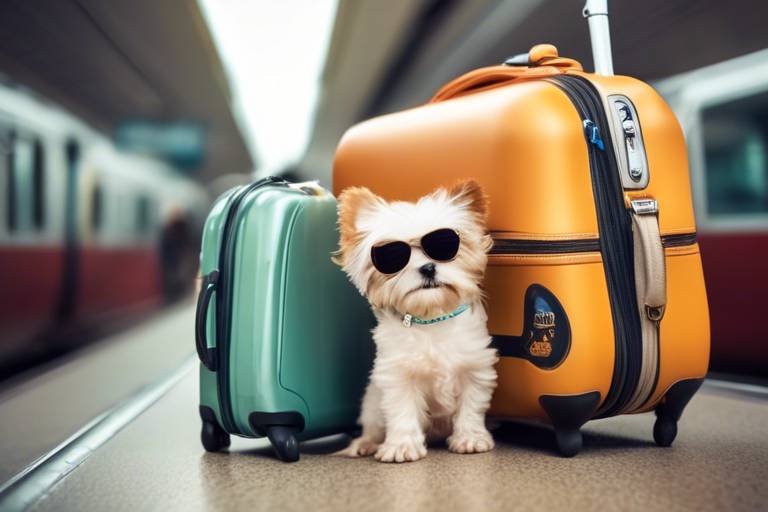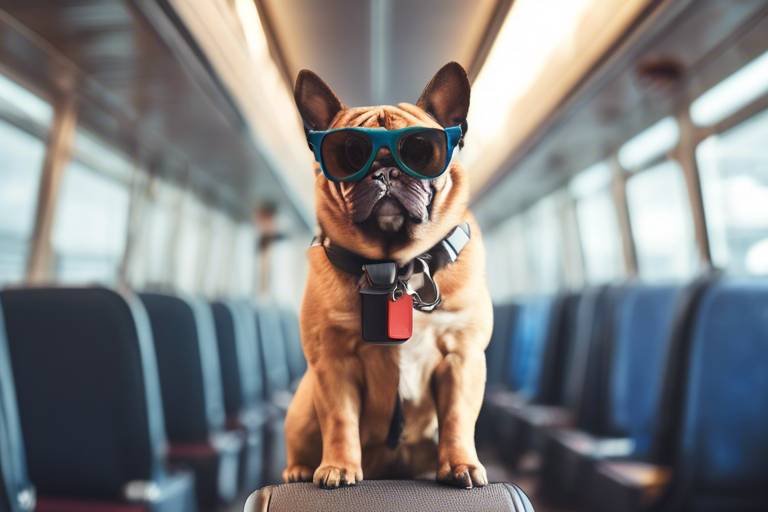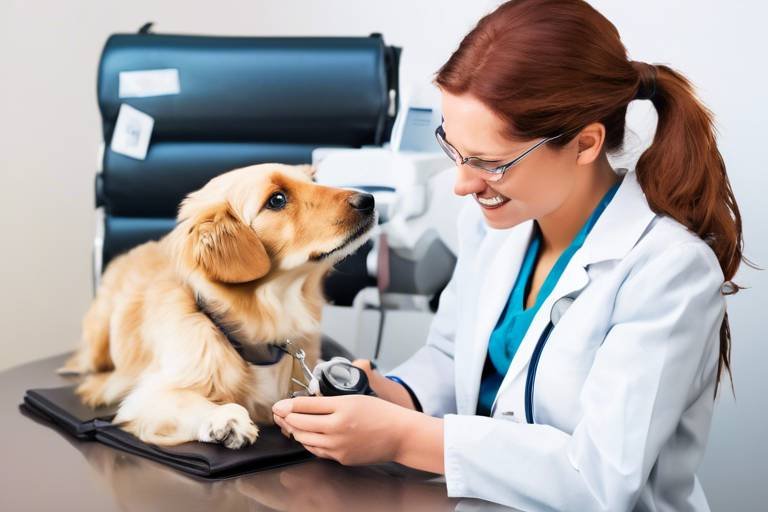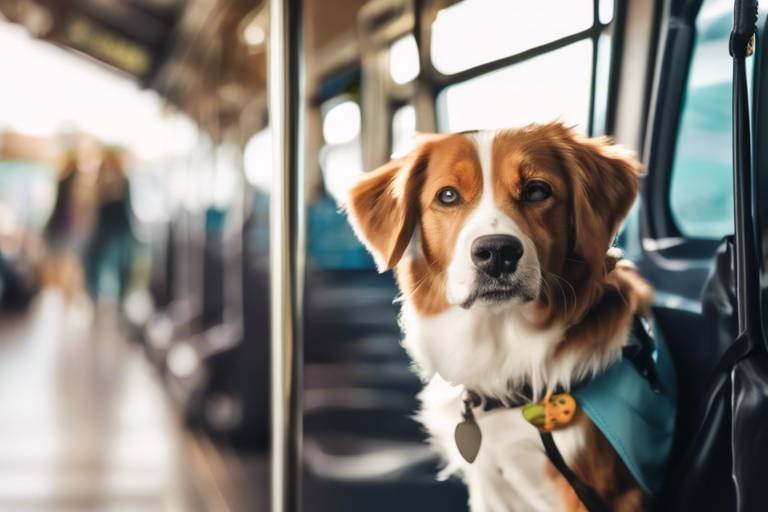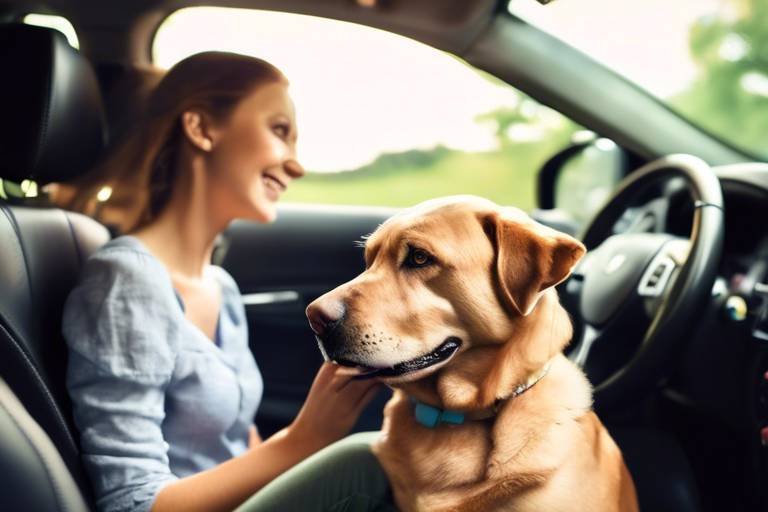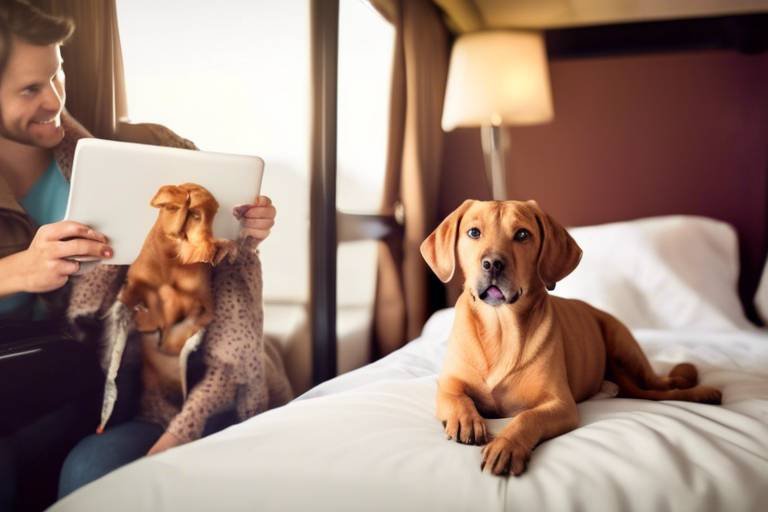How to Make the Most of Your Pet's Travel Experiences
Traveling with your pet can be one of the most rewarding experiences, enhancing the bond you share with your furry friend. Imagine the joy of exploring new places together, the wagging tails, and the shared adventures! However, to ensure that both you and your pet have a fantastic time, it’s essential to plan ahead. This article dives deep into essential tips and strategies that will help you create safe, comfortable, and enriching travel experiences for your beloved companion.
Whether you're heading to the mountains for a hike, visiting a pet-friendly beach, or simply taking a road trip, preparation is key. Before you pack up your bags and hit the road, consider the various aspects of traveling with pets, from health checks and packing necessities to familiarizing your pet with travel routes. The goal is to make your pet feel as comfortable and secure as possible, ensuring that the journey is just as enjoyable as the destination.
Choosing the right destination is equally important. Not all places are welcoming to pets, and discovering pet-friendly accommodations, attractions, and outdoor spaces can make a world of difference. Have you ever arrived at a beautiful location only to find out that your furry friend isn’t welcome? Avoiding these surprises involves doing your homework. Researching pet policies at hotels and attractions can save you from unexpected challenges and ensure a smooth experience.
Furthermore, understanding local laws regarding pets is crucial. Different regions have varying regulations, and being informed can help you avoid fines or, worse, having to leave your pet behind. Engaging in pet-friendly activities, such as visiting dog parks or hiking trails, can enhance your travel experience, allowing you to create lasting memories together.
As you prepare for your trip, don't forget about acclimating your pet to travel conditions. This means getting them used to car rides and new environments to minimize stress. Remember, a well-prepared pet is a happy pet, and a happy pet makes for a happy journey!
- What should I pack for my pet when traveling?
Make sure to include food, water, bowls, leash, waste bags, grooming supplies, and any medications your pet may need. - How can I help my pet adjust to travel?
Start with short trips to get them used to being in the car or carrier, and gradually increase the duration. - Are there specific airlines that are more pet-friendly?
Yes, some airlines have better policies for traveling with pets, so it’s worth researching beforehand. - What should I do if my pet gets anxious during travel?
Consider consulting your veterinarian about calming products or techniques that can help ease their anxiety.

Preparing for Travel
Preparation is key for a successful trip with your pet. Before you even think about hitting the road, there are several essential steps you need to take to ensure that both you and your furry friend have a safe and enjoyable experience. First things first, a visit to the vet is a must. Make sure your pet is healthy enough for travel; this includes checking for any underlying health issues and ensuring that vaccinations are up to date. You wouldn't want to embark on an adventure only to find out your pet is unwell or unvaccinated, right?
Next, it's time to pack those travel essentials. Think about what your pet will need during the journey. Here’s a quick checklist:
- Food and Water: Bring enough food for the duration of your trip, plus some extra just in case. Don't forget a portable water bowl!
- Leash and Collar: Ensure your pet has a sturdy leash and a collar with an ID tag that includes your contact information.
- Comfort Items: A favorite blanket or toy can help soothe your pet in unfamiliar environments.
- First Aid Kit: Pack a basic first aid kit tailored for pets, including any medications your pet may need.
Once you have your essentials packed, it’s time to familiarize your pet with the travel route. If you’re driving, take your pet on shorter car rides leading up to your trip. This helps them get used to the motion and sound of the vehicle. If you're flying, consider visiting the airport beforehand to help your pet acclimate to the environment. The more familiar they are with the travel conditions, the less stressed they will be during the actual trip.
Lastly, don't forget to plan for breaks during your journey. Just like you, your pet will need time to stretch their legs, relieve themselves, and hydrate. Look for pet-friendly rest stops along your route where you can take a break and let your furry companion enjoy some fresh air. A well-planned trip is not just about the destination; it's about making the journey enjoyable for both of you.
Q: How can I ensure my pet is comfortable during travel?
A: Make sure to bring familiar items like their bed or a favorite toy, and take regular breaks during long trips.
Q: What should I do if my pet gets anxious during travel?
A: Consider using calming products such as anxiety wraps or consult your vet for recommendations on safe sedatives.
Q: Are there any specific health checks I should consider before traveling?
A: Yes, it's important to have your pet's vaccinations up to date and to get a general health check from your vet.
Q: What if my pet has special dietary needs?
A: Always pack enough of their specific food and consult your vet for advice on managing their diet while traveling.

Choosing Pet-Friendly Destinations
When it comes to traveling with your furry friend, choosing the right destination can make all the difference in creating a memorable adventure. Think of it as picking the perfect playground for your pet; not every spot will have the swings and slides they love. You want a place that not only welcomes pets but also offers activities and amenities that can enrich their experience. So, how do you find these hidden gems? Let’s dive into some essential tips!
First off, start by researching pet-friendly accommodations. Not all hotels, motels, or vacation rentals are created equal. Some places might allow pets but have restrictions on size or breed, while others might charge hefty fees. Websites like BringFido and Airbnb can be great resources to find places that openly welcome your four-legged companions. Always read the reviews; fellow pet owners often share their experiences, which can give you insights into what to expect.
Next, consider the attractions and outdoor spaces available at your destination. Parks, beaches, and hiking trails can be fantastic places to explore together. For instance, if you’re heading to a beach town, look for pet-friendly beaches where your pup can frolic in the sand and splash in the waves. Similarly, many national parks have designated areas where pets are allowed, making them perfect for adventurous spirits. But remember, not all parks are pet-friendly, so do your homework ahead of time!
Another crucial aspect is to understand local pet policies. Different regions have varying rules regarding pets in public spaces. For example, some cities may require pets to be leashed at all times, while others might have specific areas where pets are allowed to roam freely. Familiarizing yourself with these regulations can save you from unexpected fines or stressful situations. A quick search online or a call to the local visitor center can provide you with the information you need.
Lastly, don't forget to look for pet-friendly activities. Whether it’s a dog-friendly café where you can enjoy a cup of coffee while your pup relaxes at your feet or a local event that welcomes pets, these activities can enhance your travel experience. Engaging in fun activities together not only strengthens your bond but also creates lasting memories. Imagine hiking a scenic trail, only to find a hidden waterfall where your dog can take a refreshing dip—pure bliss!
In summary, choosing pet-friendly destinations requires a bit of research and planning, but the rewards are well worth the effort. By finding accommodations that welcome pets, exploring attractions that cater to their needs, understanding local policies, and engaging in pet-friendly activities, you can ensure that both you and your furry companion have an unforgettable travel experience.
- What should I look for in a pet-friendly hotel? Look for hotels that explicitly state they are pet-friendly, check for size or breed restrictions, and read reviews from other pet owners.
- Are there any destinations that are better for pets? Destinations with ample parks, beaches, and outdoor activities tend to be more pet-friendly.
- How can I find pet-friendly attractions? Websites and apps dedicated to pet travel can help you find attractions that allow pets.
- What should I do if a destination has strict pet policies? Consider alternative locations or look for pet-sitting services in the area so your pet can stay comfortable while you explore.
Researching Pet Policies
When planning a trip with your furry friend, one of the most critical steps is at your chosen accommodations and attractions. You wouldn't want to arrive at a hotel only to discover that your pet isn't welcome, right? That could lead to unnecessary stress for both you and your pet, not to mention potential costs for last-minute changes. So, how do you ensure that your travels go as smoothly as possible?
First, start by checking the official websites of the places you intend to stay or visit. Most hotels, vacation rentals, and attractions will have a dedicated section for their pet policies. Look for information on size restrictions, additional fees, and any specific rules they might have, such as leash requirements or designated pet areas.
It’s also a smart idea to read customer reviews on travel websites or forums. Often, fellow pet owners will share their experiences, which can provide valuable insights. For instance, you might find out that a hotel claims to be pet-friendly but has a reputation for being unwelcoming to four-legged guests. This kind of feedback can save you a lot of hassle.
If the information isn’t clear or if you have specific questions, don’t hesitate to call ahead. Speaking directly with a staff member can clarify any doubts and give you peace of mind. Ask about their pet policy, any extra charges, and what amenities they offer for pets. Some hotels even provide dog beds, bowls, and treats, making your pet feel right at home!
To help you keep track of the pet policies you find, consider creating a simple
| Accommodation/Attraction | Pet Policy | Fees | Additional Notes |
|---|---|---|---|
| Hotel XYZ | Dogs allowed, max weight 50 lbs | $25 per night | Pet-friendly amenities available |
| Park ABC | Leashed pets welcome | Free | Designated pet areas |
Lastly, don't forget to check any local regulations regarding pets in the area you plan to visit. Some cities have strict leash laws or specific places where pets are not allowed. Being informed will not only keep you compliant but also ensure you and your pet can enjoy your trip without any hiccups.
In summary, thorough research on pet policies before your journey can significantly enhance your travel experience. By knowing what to expect, you can avoid unpleasant surprises and focus on creating wonderful memories with your beloved companion.
- What should I do if my pet is not allowed in a hotel? Consider looking for nearby pet-friendly accommodations or investigate pet-sitting services in the area.
- Are there any specific breeds that are often restricted? Yes, some hotels may have restrictions on certain breeds due to insurance policies. Always check in advance.
- Can my pet stay with me at restaurants? It depends on local laws and the restaurant's pet policy. Some places may have outdoor seating that allows pets.
Understanding Local Laws
When it comes to traveling with your furry friend, understanding local laws is paramount. Different regions have their own regulations regarding pets, and being unaware of these can lead to unexpected fines or, worse yet, having to leave your pet behind. For instance, some cities may have leash laws that require pets to be on a leash at all times in public spaces, while others might have specific breed restrictions. It’s like playing a game where each level has its own rules, and if you don’t know them, you might just lose the game!
Before you embark on your adventure, take some time to research the local laws of your destination. This can include:
- Leash Laws: Are pets required to be leashed in public areas?
- Breed Restrictions: Are there any breeds that are prohibited or restricted?
- Pet Licensing: Do you need to register your pet with local authorities?
- Noise Regulations: Are there noise ordinances that could affect your pet, especially in rental properties?
- Public Transport Rules: What are the guidelines for bringing pets on public transportation?
Additionally, some parks or recreational areas may have specific rules about pet access, such as designated pet-friendly zones or seasonal restrictions. Ignoring these regulations can lead to hefty fines or, in some cases, being banned from certain areas. To avoid these pitfalls, consider creating a simple table to summarize the laws of each destination you plan to visit:
| Destination | Leash Law | Breed Restrictions | Pet Licensing Required | Public Transport Rules |
|---|---|---|---|---|
| City A | Required | None | No | Allowed in carriers |
| City B | Not required | Restricted breeds | Yes | Not allowed |
| City C | Required | None | No | Allowed |
By taking these precautions and being informed, you can ensure a smooth travel experience for both you and your pet. Remember, knowledge is power, and when it comes to traveling with your pet, being aware of the local laws can make all the difference between a fun adventure and a stressful situation.
Q: What should I do if I’m unsure about local pet laws?
A: It's best to check the official city or county website of your destination. You can also reach out to local pet organizations or veterinarians for guidance.
Q: Are there any resources for finding pet-friendly areas?
A: Yes! Websites like BringFido or PetFriendly can provide valuable information about pet-friendly parks, accommodations, and activities in various locations.
Q: Can I take my pet on public transportation?
A: It depends on the local regulations. Many cities allow pets on public transport if they are in carriers, but some may have restrictions, so always check beforehand.
Finding Pet-Friendly Activities
When it comes to traveling with your furry friend, one of the most exciting aspects is discovering pet-friendly activities that both you and your pet can enjoy together. Imagine hiking up a scenic trail with your dog, or exploring a charming town with your cat in tow—these experiences can strengthen your bond and create lasting memories. However, finding suitable activities requires a bit of research and planning.
Start by looking for local parks and nature reserves that allow pets. Many cities have designated dog parks where your pup can run free and socialize with other dogs. These parks often feature agility equipment and spacious areas for play, making them perfect for letting off some steam. If you prefer a more natural setting, consider hiking trails that are known to be pet-friendly. Websites like AllTrails or local tourism boards can provide valuable information on trails that welcome pets, including any restrictions or leash requirements.
Another fun option is to check out pet-friendly beaches. Many coastal areas have sections where dogs are allowed to run and play in the sand and surf. Just be sure to bring plenty of water, a shade umbrella, and some toys to keep your pet entertained. If you’re a fan of the arts, look for local events or festivals that welcome pets. Many outdoor markets and fairs are becoming more inclusive, allowing pets to join in the fun, which can be a great way to socialize and enjoy the community atmosphere.
For those who enjoy a more leisurely pace, consider visiting pet-friendly cafes or restaurants. Many establishments now offer outdoor seating where pets are welcome. This can be a delightful way to unwind after a day of exploring, allowing you to enjoy a meal or a cup of coffee while your pet relaxes by your side. Don't forget to check if they have special dog treats on the menu—your furry friend will appreciate the extra attention!
Lastly, check out local pet shops or pet-friendly tours. Some cities offer guided tours that allow pets, whether it's a walking tour or a boat ride. These experiences can provide a unique perspective on the area while ensuring your pet is included in the adventure. Remember, the key to finding the best activities is to do your homework—look for reviews, ask locals, and explore online resources to uncover hidden gems that cater to both you and your pet.
In summary, the world is full of exciting activities that you can enjoy with your pet. From parks and beaches to cafes and tours, the options are endless. So, grab your leash, pack some snacks, and get ready to create unforgettable memories with your furry companion!
- What should I consider when choosing pet-friendly activities?
Consider your pet's energy level, temperament, and any specific needs they might have. Always check if there are any restrictions, such as leash laws or designated areas for pets.
- Are there any apps or websites to help find pet-friendly places?
Yes! Websites like BringFido and apps like DogFriendly can help you find pet-friendly accommodations, restaurants, and activities in your area.
- Can I take my pet on public transportation?
This varies by location. Many public transportation systems allow pets but may have specific rules, such as requiring them to be in a carrier or on a leash. Always check the local regulations before traveling.
Preparing Your Pet for Travel
Traveling with your furry friend can be an exhilarating experience, but it requires a bit of preparation to ensure that both you and your pet have a stress-free adventure. First and foremost, it's essential to acclimate your pet to travel conditions. This means getting them comfortable with car rides or any other mode of transport you plan to use. Start with short trips around the neighborhood to help them adjust. Just like humans, pets can feel anxious in unfamiliar environments, so gradually increasing the duration of these trips can help ease their nerves.
Next, consider the importance of creating a familiar environment for your pet. Bring along their favorite blanket or toy; these items can provide a sense of comfort and security during the journey. It's also wise to pack a travel bag specifically for your pet. This bag should include essentials like food, water, bowls, leashes, waste bags, and any medications they might need. Having everything in one place not only makes packing easier but ensures you won’t forget anything important.
Moreover, health checks are a crucial part of preparing for travel. Schedule a visit to the vet to ensure your pet is fit for travel. This is especially important if you’re traveling long distances or to a new location. Your vet can provide advice on how to manage any specific health concerns and may even recommend medications for anxiety or motion sickness. Don't forget to bring along any necessary health records, especially if you’re crossing state lines or traveling internationally. Some destinations may require proof of vaccinations or health certificates.
Lastly, familiarize your pet with the travel route. If you're traveling by car, consider letting your pet explore the vehicle before the trip. Allow them to sit in their designated spot and get used to the smells and sounds. If you're flying, take them to the airport beforehand if possible, or simulate the experience at home. This can help reduce anxiety and make the actual travel day less overwhelming. Remember, the goal is to create a positive travel experience for your pet, so patience and preparation are key!
- How can I tell if my pet is ready to travel? Look for signs of anxiety or discomfort during short trips. If they seem relaxed and happy, they’re likely ready for longer journeys.
- What should I do if my pet gets motion sickness? Consult your vet for advice. They may recommend medication or suggest travel strategies to minimize discomfort.
- Are there specific carriers required for air travel? Yes, airlines have specific regulations regarding pet carriers. Ensure yours is well-ventilated and meets size requirements.
- How can I help my pet adjust to a new environment? Bring familiar items, maintain a routine, and give them time to explore their new surroundings at their own pace.

Traveling by Car
Traveling by car with your pet can be one of the most enjoyable experiences, but it requires a bit of planning to ensure both you and your furry friend have a smooth ride. Just like humans, pets can feel anxious or uncomfortable during long drives, so it's crucial to consider their needs. First and foremost, you should always prioritize your pet's safety. This means using a secure crate or a pet seat belt to keep your companion safe while you're on the road. Imagine driving with your pet bouncing around the car; it’s not only distracting but also dangerous! A properly secured pet can help you focus on the road and make the journey more enjoyable for both of you.
Another important aspect to consider is comfort. Just as you would pack your own travel essentials, you should also pack for your pet. Bring along their favorite blanket or bed to help them feel at home in the car. Additionally, don’t forget to have plenty of water and snacks on hand to keep them hydrated and energized during the trip. Frequent breaks are essential, too! Plan to stop every couple of hours to let your pet stretch their legs and relieve themselves. This not only helps keep them comfortable but also breaks up the monotony of a long drive.
Here are some tips to enhance your car travel experience:
- Crate Training: If your pet is not already accustomed to traveling in a crate, it might be beneficial to start crate training before your trip. A crate can provide a safe space for your pet and help them feel secure.
- Frequent Breaks: Schedule regular breaks every two to three hours. This gives your pet a chance to stretch, hydrate, and relieve themselves, preventing discomfort.
- Temperature Control: Ensure your car is at a comfortable temperature. Pets can overheat quickly, so never leave them alone in a locked car.
Remember, the journey is just as important as the destination. By taking these precautions and being mindful of your pet's needs, you can transform a simple car ride into a memorable adventure. After all, your pet is not just a passenger; they are your travel companion, and sharing these experiences can significantly strengthen the bond between you two. So buckle up, and get ready for some tail-wagging fun!
Q: How can I prevent my pet from getting car sick?
A: To prevent motion sickness, try feeding your pet a light meal a few hours before the journey and avoid feeding them right before you hit the road. You can also consult your veterinarian about anti-nausea medication if your pet is prone to car sickness.
Q: What should I do if my pet gets anxious during the drive?
A: If your pet shows signs of anxiety, consider bringing along their favorite toys or blankets for comfort. You can also play soothing music or use calming sprays designed for pets. In severe cases, consult your vet about potential calming medications.
Q: Is it safe to let my pet stick their head out of the window?
A: While it might look cute, it's not safe to let your pet stick their head out of the window. Debris can injure them, and sudden stops can cause them to fall out. Keep the windows partially open for fresh air instead.
Safety Tips for Car Travel
Traveling by car with your furry friend can be an exhilarating experience, but it’s crucial to prioritize their safety throughout the journey. First and foremost, one of the best ways to ensure your pet's safety is by using a secure pet carrier or a harness with a seatbelt. Just like we buckle up for safety, our pets deserve the same protection. A well-ventilated carrier will not only keep them secure but also provide a cozy space where they can feel safe during the ride.
Additionally, never allow your pet to roam freely in the vehicle while driving. This can be incredibly distracting and dangerous, not just for your pet but for you as a driver. Imagine your dog suddenly jumping into your lap while you’re trying to navigate a busy highway—definitely not ideal! Instead, consider using a pet seatbelt or a specialized pet car seat to keep them secure and comfortable.
Another important aspect to consider is frequent breaks. Long car rides can be exhausting for pets, just as they are for us. Make sure to schedule regular stops every couple of hours to let your pet stretch their legs, relieve themselves, and hydrate. This not only helps prevent restlessness but also keeps them comfortable throughout the journey. During these breaks, you can also take the opportunity to check on their well-being and adjust their space if necessary.
It's also wise to keep your vehicle's temperature regulated. Pets can overheat quickly, especially if they are left in a parked car or if the air conditioning isn’t functioning properly. Always ensure that the temperature inside the car is comfortable for your pet, and never leave them alone in the vehicle, even for a short period. The heat can rise dangerously fast, putting your pet at risk.
In case of an emergency, it’s beneficial to have a pet first-aid kit on hand. This kit should include essentials like bandages, antiseptic wipes, and any medications your pet may need. You never know when an unexpected situation might arise, so being prepared can make all the difference. Here’s a quick look at what to include in your pet first-aid kit:
| Item | Purpose |
|---|---|
| Bandages | To cover cuts and scrapes |
| Antiseptic Wipes | To clean wounds |
| Pet-Safe Pain Reliever | To alleviate mild pain |
| Gauze | For wrapping larger wounds |
| Leash | To keep your pet secure during stops |
Lastly, remember to keep your pet's identification up to date. In the unfortunate event that they escape or get lost during your travels, having a collar with an ID tag and a microchip can be crucial in reuniting you with your furry companion. It’s like having a backup plan for your backup plan—always better to be safe than sorry!
By following these safety tips, you can ensure that your car travel experience with your pet is not only enjoyable but also safe. After all, the journey should be as fun as the destination!
- What should I do if my pet gets car sick? - Gradually acclimate them to car rides, limit food before travel, and consult your vet for anti-nausea medication if necessary.
- Is it safe to let my pet stick their head out the window? - No, this can be dangerous as they may be injured by flying debris or sudden stops.
- How can I keep my pet calm during the ride? - Bring their favorite toys, blankets, and consider calming music or pheromone sprays to create a soothing environment.
Managing Motion Sickness
Motion sickness is a common issue that can affect our furry friends just as much as it can affect us. Imagine the excitement of hitting the road with your pet, only to find them feeling queasy and uncomfortable. It's heart-wrenching, isn't it? But don't fret! There are several strategies you can employ to help minimize the chances of your pet experiencing motion sickness during travel.
First and foremost, acclimating your pet to travel conditions is essential. Start by taking your pet on short car rides that gradually increase in duration. This can help them get used to the sensation of being in a moving vehicle without overwhelming them. For instance, begin with a quick trip to the local park and gradually extend the distance as your pet becomes more comfortable. Just like us, pets can develop a tolerance over time!
Another effective way to manage motion sickness is to ensure your pet travels on an empty stomach. Feeding them a light meal a few hours before your journey can help reduce the chances of nausea. However, avoid feeding them right before you leave, as a full stomach can lead to discomfort. It's a delicate balance, much like preparing a soufflé—too much or too little can cause it to flop!
Additionally, consider using natural remedies to soothe your pet's stomach. Ginger, for example, is known for its anti-nausea properties and can be given in small doses. Always consult your veterinarian before introducing any new supplements to ensure they are safe for your pet. You might also want to look into specialized pet calming products, which can help alleviate anxiety that may contribute to motion sickness.
During the trip, keeping your pet calm is crucial. Create a cozy space in the car for them, using their favorite blanket or toy to provide comfort. You could also play soothing music or talk to them in a calm voice to ease their nerves. Just like a comforting hug from a loved one, your presence can be incredibly reassuring to your pet.
If your pet does show signs of motion sickness, such as drooling or whining, take a break. Stop the car, allow them to get some fresh air, and take a short walk if possible. This can help reset their system and alleviate some of the discomfort. Remember, patience is key—just as we might need a moment to gather ourselves after feeling unwell, so do our pets.
In summary, managing motion sickness in pets involves a combination of preparation, natural remedies, and creating a comfortable travel environment. By taking these steps, you can help ensure that your pet enjoys the journey as much as the destination, turning potential travel woes into a delightful adventure!
- What are the signs of motion sickness in pets? Look for symptoms such as drooling, whining, restlessness, or vomiting during car rides.
- Can I give my pet medication for motion sickness? Yes, consult your veterinarian for suitable medications that can help manage your pet's motion sickness.
- How can I help my pet feel more comfortable during travel? Create a cozy space for them in the car, use calming products, and take breaks during long trips.
- Is it safe to feed my pet before a car trip? It's best to feed them a light meal a few hours before travel to avoid nausea.

Traveling by Air
Air travel can be a thrilling adventure for both you and your furry companion, but it also comes with its own set of challenges. Imagine the excitement of soaring through the clouds with your pet by your side! However, to make this experience as smooth as possible, it’s crucial to be well-prepared. First and foremost, understanding airline policies is essential. Each airline has different regulations regarding pet travel, including size restrictions, carrier specifications, and fees. So, before you book that flight, make sure to do your homework!
When it comes to choosing the right carrier for your pet, comfort and compliance with airline regulations are paramount. You want your pet to feel cozy and secure during the flight, while also ensuring that the carrier meets the airline's standards. Look for carriers that are well-ventilated, spacious enough for your pet to stand and turn around, and sturdy enough to withstand the rigors of travel. Additionally, consider adding familiar items like a favorite blanket or toy to help ease your pet's anxiety.
Another important aspect of air travel with pets is preparing for security checks at the airport. This can be a daunting experience, but with some preparation, it doesn't have to be! Make sure to arrive at the airport early to give yourself ample time to navigate through security. When you get to the security checkpoint, you may need to remove your pet from the carrier, so having a leash handy is a good idea. It's also wise to have all necessary documentation, such as health certificates and vaccination records, easily accessible in case they are requested by airport personnel.
While waiting for your flight, keep your pet engaged and calm. Take them for a walk around the airport, allowing them to stretch their legs and relieve themselves. Airports often have designated pet relief areas, so be sure to locate these spots. Also, remember to keep your pet hydrated, but don’t overdo it right before the flight to avoid any accidents during travel.
Once you board the plane, it's time to settle in. If your pet is traveling in the cabin with you, make sure they are calm and comfortable in their carrier under the seat in front of you. Talk to them softly and offer treats to reassure them. If your pet is traveling in the cargo hold, ensure that they are secured in a sturdy carrier, and that it is clearly labeled with your contact information. It’s a good idea to check in with the airline staff to confirm that your pet has been loaded safely onto the plane.
Finally, once you land, give your pet some time to adjust to the new environment. They might be a little disoriented after the flight, so allow them to sniff around and explore their new surroundings. Ensuring your pet has a smooth transition after air travel is just as important as the journey itself.
In summary, traveling by air with your pet can be a fulfilling experience if you take the necessary precautions. By understanding airline policies, choosing the right carrier, preparing for security checks, and ensuring your pet's comfort throughout the journey, you can create unforgettable memories together. Keep these tips in mind, and you'll both be ready to embark on your next adventure!
- What documents do I need to travel with my pet by air?
You typically need a health certificate issued by a veterinarian, proof of vaccinations, and sometimes an import permit depending on your destination. - Can my pet sit on my lap during the flight?
This depends on the airline's policy. Many airlines allow small pets in the cabin, but they must remain in their carrier under the seat in front of you. - How do I help my pet adjust to air travel?
Gradually acclimate your pet to their carrier before the trip, take short car rides, and provide familiar items to make them feel secure. - What should I do if my pet gets anxious during the flight?
Consider speaking to your vet about anxiety-reducing medications or natural remedies that can help calm your pet during the flight.
Choosing the Right Carrier
When it comes to air travel, selecting the right carrier for your pet is crucial. It's not just about aesthetics; it's about ensuring your furry friend’s safety and comfort during the flight. A well-chosen carrier can make the difference between a stressful journey and a smooth adventure. So, what should you look for when picking a carrier? Let’s break it down!
First and foremost, the size of the carrier is essential. Your pet should be able to stand, turn around, and lie down comfortably. A cramped space can lead to anxiety and discomfort, which is the last thing you want during a flight. To help you visualize the right dimensions, here's a simple table:
| Pet Size | Carrier Dimensions (L x W x H) |
|---|---|
| Small (up to 10 lbs) | 18" x 12" x 10" |
| Medium (10-20 lbs) | 24" x 16" x 14" |
| Large (20-30 lbs) | 30" x 20" x 19" |
In addition to size, consider the material of the carrier. Soft-sided carriers are often preferred for their flexibility and comfort, but they must be sturdy enough to withstand the rigors of travel. Look for carriers with reinforced seams and a strong zipper. If your pet is a bit of an escape artist, a hard-sided carrier might be a better choice, providing a secure environment.
Another important factor is ventilation. Good airflow is vital, especially for longer flights. Ensure that the carrier has sufficient mesh panels or holes to allow air circulation. This will help keep your pet calm and comfortable, preventing overheating during the journey.
Don’t forget about the ease of access! A carrier with a top or side opening allows for easy loading and unloading, which can be a lifesaver at busy airports. Also, consider carriers with pockets for storing essential items like treats, toys, and documents. This way, you won’t be fumbling around when you need something quickly.
Lastly, check the airline regulations regarding pet carriers. Each airline has specific requirements regarding dimensions, materials, and even the types of pets allowed in the cabin. It’s a good idea to double-check these guidelines before purchasing a carrier to avoid any last-minute surprises at the airport.
In summary, choosing the right carrier involves a combination of size, material, ventilation, accessibility, and compliance with airline policies. By taking the time to select the perfect carrier, you’re not just ensuring a smoother travel experience for your pet; you’re also enhancing the bond you share. After all, a happy pet makes for a happy traveler!
- What size carrier do I need for my pet? - The carrier should allow your pet to stand, turn, and lie down comfortably. Refer to the size chart above for guidance.
- Can I use a soft-sided carrier for air travel? - Yes, as long as it meets the airline’s requirements. Soft-sided carriers are often more comfortable for pets.
- How can I help my pet adjust to the carrier? - Gradually introduce your pet to the carrier at home, allowing them to explore and get comfortable before the trip.
Preparing for Security Checks
Traveling with your furry friend can be an exhilarating experience, but navigating airport security can feel like a daunting obstacle course. To ensure a smooth and stress-free process, it’s essential to prepare in advance. First, familiarize yourself with the specific security policies of the airline you’re flying with, as these can vary from one airline to another. Knowing what to expect can save you from unnecessary stress and confusion.
One of the most important steps is to choose the right carrier for your pet. Make sure it meets the airline's size requirements and is well-ventilated. A comfortable carrier can help your pet feel secure, which is crucial during the hustle and bustle of the airport. Before your trip, practice getting your pet accustomed to the carrier by allowing them to explore it at home. This will help them associate the carrier with positive experiences, reducing anxiety when it’s time to travel.
When you arrive at the airport, keep your pet on a leash and be prepared to take them out of their carrier during the security screening. Security personnel may ask to inspect your pet separately, so having a sturdy leash and harness is vital. Additionally, consider bringing some familiar items, like a favorite toy or blanket, to comfort your pet during the wait. Remember, the goal is to keep your pet calm and reassured amidst the busy airport environment.
Here are a few tips to keep in mind as you prepare for security checks:
- Arrive Early: Give yourself plenty of time to navigate the airport and security checks.
- Stay Calm: Your pet can pick up on your emotions, so try to remain calm and composed.
- Have Documentation Ready: Keep your pet's health records and any necessary travel documents accessible.
Lastly, be patient. Airports can be overwhelming for both pets and their owners, but with the right preparation, you can make the experience as smooth as possible. By planning ahead and following these guidelines, you and your furry companion can breeze through security and focus on the adventure that awaits you!
Q: What documents do I need to travel with my pet?
A: Typically, you will need a health certificate from your veterinarian, proof of vaccinations, and any specific documents required by the airline or destination.
Q: Can I bring my pet in the cabin with me?
A: Many airlines allow small pets to travel in the cabin if they are in an approved carrier. Always check with your airline for their specific policies.
Q: How can I help my pet avoid anxiety during travel?
A: Familiarizing your pet with their carrier, providing comfort items, and maintaining a calm demeanor can help ease their anxiety during travel.

Post-Travel Care
After an adventurous journey with your furry friend, it’s crucial to focus on . Just like humans, pets can experience a range of emotions and physical reactions after traveling. This phase is not just about settling back into your routine; it’s an opportunity to ensure your pet is healthy, happy, and ready for the next adventure!
First and foremost, monitor your pet closely for any signs of stress or discomfort. You might notice them acting differently or being a bit more clingy than usual. This is perfectly normal! Travel can be overwhelming for pets, and they may need some extra love and attention to readjust. Make sure to give them plenty of cuddles and reassurance. After all, they’ve just been on a whirlwind journey with you!
It’s also a good idea to check for any physical issues that might have arisen during travel. Look for signs such as:
- Excessive panting or drooling
- Changes in appetite
- Unusual behavior like hiding or aggression
- Signs of motion sickness such as vomiting or lethargy
If you notice any concerning symptoms, don’t hesitate to contact your vet. It’s better to be safe than sorry, and your veterinarian can provide guidance on whether your pet needs a check-up.
Re-establishing routines is another vital part of post-travel care. Pets thrive on consistency, and returning to their normal feeding, walking, and play schedules can help them feel secure again. Gradually reintroducing them to their usual activities can also help ease any lingering anxiety they might have from the trip.
Additionally, consider giving your pet some time to unwind. Just like we enjoy a lazy day after a trip, your furry companion might appreciate a cozy spot to relax. Create a comfortable space with their favorite blanket or toy, allowing them to decompress and feel at home again.
Lastly, don’t forget to maintain a record of your travels. Keeping a travel journal or a scrapbook can be a fun way to reminisce about your adventures together. You can include photos, ticket stubs, or even notes about your pet's reactions to different experiences. This not only strengthens your bond but also helps you plan even better trips in the future!
Q: What should I do if my pet shows signs of stress after travel?
A: It’s important to give your pet some extra attention and reassurance. Monitor their behavior, and if symptoms persist, consult your veterinarian.
Q: How can I help my pet adjust back to their routine?
A: Gradually reintroduce their normal feeding, walking, and play schedules. Consistency is key to helping them feel secure.
Q: Is it normal for pets to be clingy after travel?
A: Yes! Pets may seek comfort from their owners after an adventure. Offering cuddles and attention can help them feel more at ease.
Q: Should I take my pet to the vet after traveling?
A: If you notice any unusual behavior or physical symptoms, it’s a good idea to consult your vet for advice.
Frequently Asked Questions
- What should I do to prepare my pet for travel?
Preparing your pet for travel involves several steps. Start with a visit to the vet to ensure your furry friend is healthy and up-to-date on vaccinations. Familiarize your pet with travel conditions by taking them on short car rides. Pack essential items like food, water, a leash, and any medications they may need. Don't forget their favorite toys or blankets to make them feel more comfortable in new environments!
- How can I find pet-friendly accommodations?
Finding pet-friendly accommodations is easier than you might think! Use online resources like travel websites or apps that filter for pet-friendly options. Always call ahead to confirm their pet policies, as some places may have specific size or breed restrictions. Don't hesitate to ask about nearby parks or pet-friendly attractions to make the most of your stay!
- What are the best practices for car travel with pets?
When traveling by car with your pet, safety and comfort are key. Use a pet seatbelt or a secure crate to keep your furry friend safe during the ride. Plan for regular breaks to let them stretch their legs and relieve themselves. Keep the car well-ventilated and avoid feeding them a large meal right before the trip to reduce the risk of motion sickness.
- How can I help my pet if they get motion sickness?
If your pet suffers from motion sickness, there are several strategies you can try. Gradually acclimate them to car rides by taking shorter trips and rewarding them with treats. Consult your vet for possible medications that can help reduce nausea. Keeping the car cool and avoiding heavy meals before travel can also make a significant difference!
- What should I know about air travel with my pet?
Air travel can be quite different from car travel, and it's essential to prepare properly. Check with the airline for their specific pet policies and ensure you have a suitable carrier that meets their requirements. Familiarize your pet with the carrier before the trip, and consider using calming aids if your pet is anxious. Arriving early at the airport can help you navigate security checks more smoothly.
- How can I assess my pet's health after traveling?
After your travels, keep an eye on your pet's behavior and health. Look for signs of stress, such as excessive barking, hiding, or changes in appetite. Re-establish their routine as soon as possible, including feeding and exercise schedules. If you notice any unusual symptoms, don't hesitate to consult your veterinarian for advice.

